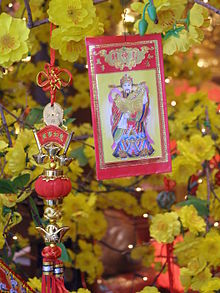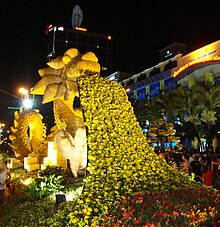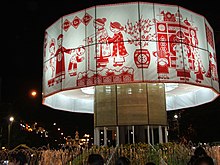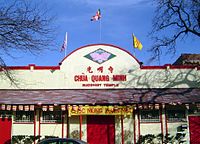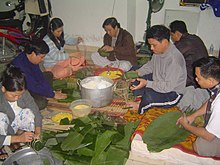Tết is celebrated on the same day as Chinese New Year, though exceptions arise due to the one-hour time difference between Hanoi and Beijing resulting in the alternate calculation of the new moon. It takes place from the first day of the first month of the Lunar calendar (around late January or early February) until at least the third day. Many Vietnamese prepare for Tết by cooking special holiday foods and cleaning the house. There are a lot of customs practiced during Tết, such as visiting a person's house on the first day of the new year (xông nhà), ancestral worshipping, wishing New Year's greetings, giving lucky money to children and elderly people, and opening a shop.
Tết is also an occasion for pilgrims and family reunions. During Tết, Vietnamese visit their relatives and temples, forgetting about the troubles of the past year and hoping for a better upcoming year. They consider Tết to be the first day of spring and the festival is often called Hội xuân (spring festival).
Contents |
Customs
Vietnamese people usually return to their families during Tết. Some return to worship at the family altar or visit the graves of their ancestors in their homeland. They also clean the grave of their family as a sign of respect. Although Tết is a national holiday among all Vietnamese, each region and religion has its own customs.Tết in the three Vietnamese regions can be divided into three periods, known as Tất Niên (penultimate New Year's Eve), Giao Thừa (New Year's Eve), and Tân Niên (the New Year), representing the preparation before Tết, the eve of Tết, and the days of and following Tết, respectively. All of these customs are to celebrate Tết in Vietnam.
Before New Year's Eve
This period begins one or two weeks before the actual celebration. The general atmosphere leading up to Tết is in the bustle of shopping, decorating the home, cooking traditional Tết food and waiting for relatives to return home. People try to pay off their debts in advance so that they can be debt-free on Tết. Parents buy new clothes for their children so that the children can wear them when Tết arrives. In the days leading up to Tết, the streets and markets are full of people. As the shops will be closed during Tết, people try to stock up on supplies as much as possible.Vietnamese families usually have a family altar, to show respect to their ancestors. During Tết the altar is thoroughly cleaned and new offerings are placed there. This includes a tray of five different fruits on the altar called "Mâm Ngũ Quả" (literally, five fruits type). Traditionally, the three kitchen guardians for each house (Ông Táo) (Kitchen God), who report to the Jade Emperor about the events in that house over the past year, return to heaven on the 23rd day of the twelfth month by lunar calendar. Their departure is marked by a modest ceremony where the family offers sacrifices for them to use on their journey.
In the days leading up to Tết, each family cooks special holiday foods such as bánh chưng and bánh dầy. Preparations for these foods are quite extensive. Family members often take turns to keep watch on the fire overnight, telling each other stories about Tết of past years.
The New Year
The first day of Tết is reserved for the nuclear family. Children receive a red envelope containing money from their elders. This tradition is called mừng tuổi (happy new age) in the north and lì xi in the south. Usually, children wear their new clothes and give their elders the traditional Tết greetings before receiving the money. Since the Vietnamese believe that the first visitor a family receives in the year determines their fortune for the entire year, people never enter any house on the first day without being invited first. The act of being the first person to enter a house on Tết is called xông đất, xông nhà or đạp đất, which is one of the most important rituals during Tết. According to Vietnamese tradition, if good things come to the family on the first day of the lunar New Year, the entire following year will also be full of blessings. Usually, a person of good temper, morality and success will be the lucky sign for the host family and be invited first into the house. However, just to be safe, the owner of the house will leave the house a few minutes before midnight and come back just as the clock strikes midnight to prevent anyone else entering the house first who might potentially bring any unfortunate events in the new year to the household.Sweeping during Tết is taboo or xui (unlucky), since it symbolizes sweeping the luck away; that is why they clean before the new year. It is also taboo for anyone who experienced a recent loss of a family member to visit anyone else during Tết.
During subsequent days, people visit relatives and friends. Traditionally but not strictly, the second day of Tết is usually reserved for friends, while the third day is for teachers, who command respect in Vietnam. Local Buddhist temples are popular spots as people like to give donations and to get their fortunes told during Tết. Children are free to spend their new money on toys or on gambling games such as bầu cua cá cọp, which can be found in the streets. Prosperous families can pay for dragon dancers to perform at their house. There are also public performances for everyone to watch.
Traditional Celebrations
These celebrations can last from a day up to the entire week, and the New Year is filled with people in the streets trying to make as much noise as possible using firecrackers, drums, bells, gongs, and anything they can think of to ward off evil spirits. This parade will also include different masks, and dancers hidden under the guise of what is known as the Mua Lan or Lion Dancing. The Lan is an animal between a lion and a dragon, and is the symbol of strength in the Vietnamese culture that is used to scare away evil spirits. After the parade, families and friends will come together to have a feast of traditional Vietnamese dishes, and share the happiness and joy of the New Year with one another. This is also the time where the elders will hand out to red envelopes with money to the children for good luck in exchange for Tết greetings (below).Decorations

A calligraphist writing in hán tự in preparation for Tết, at the Temple of Literature, Hanoi (2011)
At Tết every house is usually decorated by hoa mai – Ochna integerrima (in the central and southern parts of Vietnam) or hoa đào – peach flower (in the northern part of Vietnam) or hoa ban (in mountain areas). In the north, some people (especially the elite in the past) also decorate their house with a Prunus mume tree (also called mai in Vietnamese, but referring to a totally different species from Ochna integerrima). In the north or central, the kumquat tree is a popular decoration for the living room during Tết. Its many fruits symbolize the fertility and fruitfulness that the family hopes for in the coming year.
Vietnamese people also decorate their homes with bonsai and flower plants such as chrysanthemum (hoa cúc), marigold (vạn thọ) symbolizing longevity, mào gà in Southern Vietnam and paperwhite flower (thủy tiên), hoa bướm in Northern Vietnam. In the past, there was a tradition that old people tried to make their paperwhite flowers blossom right the watch-night time. They also hung up Dong Ho Paintings and thu pháp (calligraphy pictures).
Greetings
- Sống lâu trăm tuổi (Long life of 100 years): used by children for elders. Traditionally, everyone is one year older on Tết, so children would wish their grandparents health and longevity in exchange for mừng tuổi or lì xì利是.
- An khang thịnh vượng (安康興旺, Security, good health, and prosperity)
- Vạn sự như ý (萬事如意, May myriad things go according to your will)
- Sức khỏe dồi dào (Plenty of health)
- Cung hỉ phát tài, from the Cantonese Gung hy fat choy (恭喜發財, Congratulations and be prosperous)
- Tiền vô như nước (May money flow in like water): used informally
Food
In Vietnamese language, to celebrate Tết is to ăn Tết, literally meaning "eat Tết", showing the importance of food in its celebration. Some of the food is also eaten year-round, while other dishes are only eaten during Tết. Also, some of the food is vegetarian since it is believed to be good luck to eat vegetarian on Tết. Some traditional food on Tết are:- Bánh chưng and bánh dầy: essentially tightly packed sticky rice with meat or bean fillings wrapped in Dong (Phrynium placentarium) leaves. When these leaves are unavailable banana leaves can be used as a substitute. Bánh chưng (rectangular to represent Earth) and bánh dầy (circular to represent Sky) are symbolically connected with Tết and are essential in any Tết celebration. Preparation is time-consuming, and can take days to cook. The story of their origins and their connection with Tết is often recounted to children while cooking them overnight.
- Hạt Dưa: roasted watermelon seeds, also eaten during Tết.
- Dưa Hành": pickled onion and pickled cabbage.
- Củ Kiệu: pickled small leeks.
- Mứt: These dried candied fruits are rarely eaten at any time besides Tết.
- Cầu Dừa Đủ Xoài - In southern Vietnam, popular fruits used for offerings at the family altar in fruit arranging art are the custard-apple/sugar-apple/soursop (mãng cầu), coconut (dừa), papaya (đu đủ), and mango (xoài), since they sound like "cầu vừa đủ xài" ([We] pray for enough [money/resoures/funds/goods/etc.] to use) in the southern dialect of Vietnamese.
- Thịt Kho Nước Dừa Meaning "Meat Stewed in Coconut Juice", it is a traditional dish of fatty pork stomach and medium boiled eggs stewed in a broth-like sauce made overnight of young coconut juice and nuoc mam. It is often eaten with pickled bean sprouts and chives, and white rice.
Games and entertainment
People enjoy traditional games during Tết, including: bầu cua, cờ tướng, ném còn, chọi trâu, đá gà and marshmallow toss. They also participate in some competitions presenting their knowledge, strength and aestheticism, such as the bird competition and ngâm thơ competition.Firework display has also become an irreplaceable part of a Tết celebration in Vietnam. During the New Year's Eve, firework displays at major cities like Hà Nội, Ho Chi Minh City, Da Nang, are broadcast through multiple national and local TV channels, accompanied by New Year wishes of the current president.
Gặp nhau cuối năm, Year-end gathering, is a national favorite comedy show broadcast until the last 30 minutes before the New Year's Eve. The Europop song Happy New Year by Swedish band ABBA is usually played during the festival nowadays.[1]
Customs and taboos

Tet Festival in Little Saigon, Orange County, California
Dos
- One should give people lucky presents to enhance the relationship between themselves and others: new clothes, peach branches (for expelling evil), cocks/chickens (wishing for good manners), new rice (wishing for being well-fed), rice wine in a gourd (wishing for a rich and comfortable life), bánh chưng (or bánh tét) and bánh dày which symbolize sky and earth (for worshipping the ancestors), red things (red symbolizes happiness, luckiness, advantages) like watermelon, dogs (the bark – gâu gâu – sounds like the word giàu - richness in Vietnamese language), medicated oil (dầu in Vietnamese, also sounds similar to giàu).
- One should give lucky Dong Ho Paintings such as: "Gà đàn" (wishing for having many children), or "Vinh hoa", but should not give unlucky Dong Ho paintings like "Đánh ghen" related to legal proceedings.
- One should sprinkle lime powder around the house to expel evil.
- One should return all things borrowed, and pay debts before Tết.
Don'ts
- One shouldn't say or do bad things during New Year.
- One shouldn't hurt or kill animals or plants but should set them free. The reason for this originates from Buddhism's causality.
- One shouldn't sweep the house or empty out the rubbish to avoid luck and benefits going with it, especially on the first day of the new year. One shouldn't let the broom in confusion if people don't want it to be stolen.
- One shouldn't give these presents to others: clock or watch (the recipient's time is going to pass), cats (mèo in Vietnamese language pronounced like nghèo, poverty), medicine (the receiver will get ill), cuttle fish (its ink is black, an unlucky colour), writing ink (for the same reason), scissors or knives (they bring incompatibility).
- One shouldn't have duck meat because it brings unluckiness.
- One shouldn't have shrimp in case one would move backwards like shrimp, in other words, one would not succeed.
- One shouldn't let the rice-hulling mill go empty because it symbolizes failed crops.
- One shouldn't refuse anything others give or wish you during Tết.
Calendar and zodiac differences
The Chinese calendar is based on astronomical observations and is therefore dependent on what is considered the local standard time. North Vietnam switched from UTC+8 to UTC+7 on August 8, 1967, with South Vietnam doing likewise in 1975 at the end of the Vietnam War. As a result of the shift, North and South Vietnam celebrated Tết 1968 on different days.[2] The moving backwards of one hour had a similar effect to the 1929 Beijing time change and the effect of this change was also seen with the Winter Solstice of 1984. On Hanoi time the solstice fell on December 21, though on Beijing time the solstice fell on December 22.As the 11th month of the Chinese calendar must contain the Winter Solstice, it is not the month from November 23, 1984 to December 21, 1984 as per the Vietnamese calendar, but rather the one from December 22, 1984 to January 20, 1985. The effect of this is that the Vietnamese New Year would fall on January 21, 1985, whereas the Chinese New Year would fall on February 20, 1985, a one-month difference. The two calendars agreed again after a leap month lasting from March 21 to April 19 was inserted into the Vietnamese calendar.
In the Vietnamese zodiac, the cat replaces the Rabbit in the Chinese zodiac. So, a child born in the Chinese year of the Rabbit must also be born in the Vietnamese year of the cat (mẹo/mão). The Vietnamese zodiac uses the same animals as the Chinese zodiac for the remaining 11 years, though the Ox or cow of the Chinese zodiac is usually considered to be a water buffalo (sửu/trâu) in the Vietnamese zodiac.
Source: http://en.wikipedia.org/wiki/T%E1%BA%BFt



